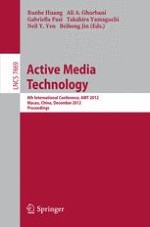2012 | Book
Active Media Technology
8th International Conference, AMT 2012, Macau, China, December 4-7, 2012. Proceedings
Editors: Runhe Huang, Ali A. Ghorbani, Gabriella Pasi, Takahira Yamaguchi, Neil Y. Yen, Beijing Jin
Publisher: Springer Berlin Heidelberg
Book Series : Lecture Notes in Computer Science
